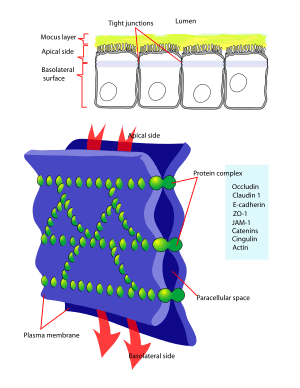Tight junction
| Tight junction | |
|---|---|
 Diagram of Tight junction | |
| Details | |
| Identifiers | |
| Latin | junctio occludens |
| TH | H1.00.01.1.02007 |
| FMA | 67397 |
Tight junctions, also known as occluding junctions or zonulae occludentes (singular, zonula occludens), are the closely associated areas of two cells whose membranes join together forming a virtually impermeable barrier to fluid. It is a type of junctional complex present only in vertebrates. The corresponding junctions that occur in invertebrates are septate junctions.
Structure
Tight junctions are composed of a branching network of sealing strands, each strand acting independently from the others. Therefore, the efficiency of the junction in preventing ion passage increases exponentially with the number of strands. Each strand is formed from a row of transmembrane proteins embedded in both plasma membranes, with extracellular domains joining one another directly. Although more proteins are present, the major types are the claudins and the occludins. These associate with different peripheral membrane proteins such as ZO-1 located on the intracellular side of plasma membrane, which anchor the strands to the actin component of the cytoskeleton. Thus, tight junctions join together the cytoskeletons of adjacent cells.
Functions
They perform vital functions:[1]
- They hold cells together.
- Barrier function, which can be further subdivided into protective barriers and functional barriers serving purposes such as material transport and maintenance of osmotic balance:
- Tight Junctions help to maintain the polarity of cells by preventing the lateral diffusion of integral membrane proteins between the apical and lateral/basal surfaces, allowing the specialized functions of each surface (for example receptor-mediated endocytosis at the apical surface and exocytosis at the basolateral surface) to be preserved. This aims to preserve the transcellular transport.
- Tight Junctions prevent the passage of molecules and ions through the space between plasma membranes of adjacent cells, so materials must actually enter the cells (by diffusion or active transport) in order to pass through the tissue. Investigation using freeze-fracture methods in electron microscopy is ideal for revealing the lateral extent of tight junctions in cell membranes and has been useful in showing how tight junctions are formed.[2] The constrained intracellular pathway exacted by the tight junction barrier system allows precise control over which substances can pass through a particular tissue. (Tight junctions play this role in maintaining the blood–brain barrier.) At the present time, it is still unclear whether the control is active or passive and how these pathways are formed. In one study for paracellular transport across the tight junction in kidney proximal tubule, a dual pathway model is proposed: large slit breaks formed by infrequent discontinuities in the TJ complex and numerous small circular pores.[3]
In human physiology there are two main types of epithelia using distinct types of barrier mechanism. Dermal structures such as skin form a barrier from many layers of keratinised squamous cells. Internal epithelia on the other hand more often rely on tight junctions for their barrier function. This kind of barrier is mostly formed by only one or two layers of cells. It was long unclear whether tight cell junctions also play any role in the barrier function of the skin and similar external epithelia but recent research suggests that this is indeed the case.[4]
Classification
Epithelia are classed as "tight" or "leaky", depending on the ability of the tight junctions to prevent water and solute movement:[5]
- Tight epithelia have tight junctions that prevent most movement between cells. Examples of tight epithelia include the distal convoluted tubule, the collecting duct of the nephron in the kidney, and the bile ducts ramifying through liver tissue.
- Leaky epithelia do not have these tight junctions, or have less complex tight junctions. For instance, the tight junction in the kidney proximal tubule, a very leaky epithelium, has only two to three junctional strands, and these strands exhibit infrequent large slit breaks.
See also

References
- ↑ Department, Biology. "Tight Junctions (and other cellular connections)". Davidson College. Retrieved 2015-01-12.
- ↑ Chalcroft, J. P.; Bullivant, S (1970). "An interpretation of liver cell membrane and junction structure based on observation of freeze-fracture replicas of both sides of the fracture". The Journal of Cell Biology. 47 (1): 49–60. doi:10.1083/jcb.47.1.49. PMC 2108397
 . PMID 4935338.
. PMID 4935338. - ↑ Guo, P; Weinstein, AM; Weinbaum, S (Aug 2003). "A dual-pathway ultrastructural model for the tight junction of rat proximal tubule epithelium.". American Journal of Physiology. Renal Physiology. 285 (2): F241–57. doi:10.1152/ajprenal.00331.2002. PMID 12670832.
- ↑ Kirschner, Nina; Brandner, JM (June 2012). "Barriers and more: functions of tight junction proteins in the skin.". Annals of the New York Academy of Sciences. 1257: 158–166. doi:10.1111/j.1749-6632.2012.06554.x.
- ↑ Department, Biology. "Tight Junctions and other cellular connections". Davidson College. Retrieved 2013-09-20.
External links
| Wikimedia Commons has media related to Tight junctions. |
- An Overview of the Tight Junction at Zonapse.Net
- Occludin in Focus at Zonapse.Net
- Tight Junctions at the US National Library of Medicine Medical Subject Headings (MeSH)
- Histology image: 20502loa – Histology Learning System at Boston University